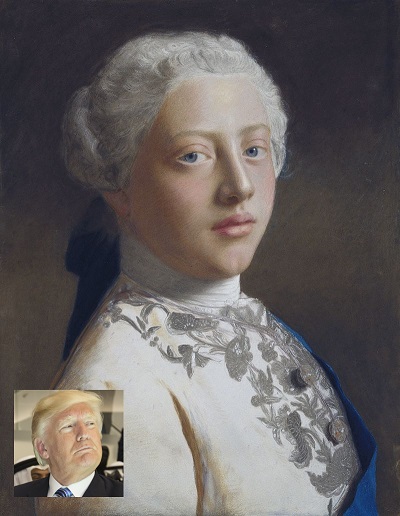The Mad King

Between 1760 and 1820, George III reigned over Britain, ascending the throne at the age of 22. The first England-born member of the Hanover house, he was well-loved. He protected the national interest of the United Kingdom, especially from revolution in France and the American colonies. He was a devoted husband and father and earned the return devotion of his family. Due to a learning disability, George III did not learn to read until he was eleven years old and was considered not to be very bright. Nonetheless, he was known to speak and write well, influencing his followers to rally around the British flag. When Parliament was having difficulty creating its government, George even offered to abdicate the throne.
But these sixty years were not at all a rosy picture. In reality, it was a roller coaster of highs and lows. There were probably many episodes of mild depression and mania which were not publicly acknowledged, but it became increasingly obvious that George III was sliding into insanity. His reign was fraught with difficulties that he did not appear to handle well. The fight against France put the kingdom in great debt. The loss of the American colonies put a strain on England and the monarch, costing him respect for himself, and a loss of respect from other countries. Foreign ambassadors found him dull and weak. Critics accused him of trying to reassert regal control over the country in an unconstitutional manner. He was inconsolable when his youngest and favorite daughter Amelia died in 1810.
George III was not a well person, suffering from blindness from cataracts, rheumatism and increasing deafness. There were bouts of convulsions, when pages actually had to sit on him to keep him on the floor. At the end of his life he could not walk. There is a lot of speculation about whether the physical aspects were triggers for the insanity, or separate results of makeup, arsenic, blue gentian and/or other medicines.
Each episode of mental incapacity appeared to be “cured” until the last one. George was removed from the public eye until he was “well” enough to again assume the throne.
The earliest dementia documented was in 1765. This was considered a brief episode. The next admitted episode was much longer, in the summer of 1778. He went to Cheltenham Spa for treatment, but the treatment did not work. By November he was seriously deranged. He would talk for hours on end, to the extent that he would foam at the mouth and his throat would get hoarse. The insanity was described as violent and he was kept in a straitjacket for a period of time. A year later he was deemed recovered and spent the next twelve years earning the love of his countrymen once more, appearing as a symbol of stability against the chaos of the French revolution.
In 1804 George again lapsed into insanity from which he recovered. During his illnesses he was ranting; his use of sentences of 400 words and eight verbs was common. His vocabulary was colorful and complex. This type of speech and writing is considered normal in the manic phase of bipolar disorder.
In 1810 the monarch slid into his final bout of insanity. He experienced occasional periods of lucidity, but they became less and less frequent, until he could no longer remember that he was king, or widowed. At Christmas, 1819, he spoke nonsense for a straight 58 hours. In 1811 Parliament named his oldest son, Prince George, as regent, to govern according to his father’s erratic will as well as he could for the next nine years.
George III died on January 29, 1820.
Medical and psychological knowledge and practices were minimal at the time, and many have tried to apply present-day knowledge to determine just what George suffered from and its cause. The information released was mitigated to protect the reputation of the royal house. We will probably never know what actually happened and why.
We need to learn from this curious time in history. A leader who tends to polarize the populace can do so by wavering back and forth between lucidity and insanity. There was a cadre of people around George that covered up periods of bad judgment and whisked him out of public view when the portrait was damaged. Nonetheless, he regularly slipped out of his confines and demonstrated his damaged mind. One of the ways the public reacted was total – and successful – revolution in France and America. In the current environment, the United States citizens and politicians still feel there are lawful options to cope with such vagaries in our leadership. Here’s hoping they are right.
© 2018 Bonnie-Jean Rohner








